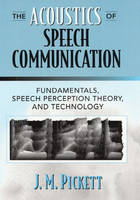
The Acoustics of Speech Communication
Pearson (Verlag)
978-0-205-19887-0 (ISBN)
- Titel ist leider vergriffen;
keine Neuauflage - Artikel merken
This is the only book to relate all three of the currently interactive areas of speech science — acoustic phonetics, speech perception, and speech technology. The book presents a gradual course: starting with a clear tutorial approach to basic acoustics of speech and then leading to successively higher levels, explaining speech perception research, the various theories of speech perception, and the modern speech technologies of computer synthesis and recognition of speech messages. The aim is to gradually bring the student through basic acoustics, spectrum analysis, vowel and consonant acoustics, and into the research literature of speech perception and technology. The technical terms, essential to understanding acoustic speech sounds and how they are produced, are all explained clearly.
The basic acoustic theory of speech production, the Source-Filter Theory, is clarified via text and diagrams. This knowledge is then applied to interpreting spectrograms of speech examples that sample all the phonetic distinctions among vowels and consonants. Distinctive acoustical patterns for vowel and consonant perception by listeners are summarized in detail based on the research literature. Critical discussions and tables provide and summarize the theories of motor, auditory, and computer recognition of speech. Consonant and vowel recognition by the hearing-impaired is described in relation to acoustic phonetic distinctions. Techniques of speech synthesis, recognition analysis by machines, and speech technologies are thoroughly explained.
All chapters conclude with “Summary.”
Preface.
I.ACOUSTIC PHONETICS: SPEECH ENCODING FROM ARTICULATION TO SOUND STREAM.
1.Language, Phonetics, and Speech Production.
Introduction: Language and Science.
How Significant Is Acoustic Phonetics?
Linguistics, Phonetics, and Phonology.
General Conditions of Speech Production.
Speech Sound Sources.
2.Sounds, Resonance, and Spectrum Analysis.
Sound Production and Propagation.
Simple Harmonic Motion.
Definitions of Sine Wave Characteristics.
Resonance.
Definition of Resonant Frequency.
Spectrum Analysis.
Definitions of Spectrum Terms.
Spectra of Recurring Resonant Oscillations.
Definitions of Harmonics.
Resonant Waves, Spectrum Plots, and Speech Waves.
Aperiodic Speech Sounds.
3.Vowel Shaping and Vowel Formants.
Model of Pharyngeal-Oral Tract.
Spectrum of the Neutral Vowel [e].
Definition of Speech Formants.
Vowel Formant Locations and Length of Pharyngeal-Oral Tract.
Vocal Tract Constrictions and Formant Frequency Locations.
Formants of Model Vowels.
Central Vowels.
4.The Glottal Sound Source and the Spectra of Vowels.
The Glottal Sound Source.
The Phonation Mechanism.
The Spectrum of the Glottal Sound Source.
Source-Filter Theory of Vowel Production.
Visualizing Speech Sounds.
Anatomy of Spectrogram.
Spectrograms of Vowels.
Nasalization of Vowels.
Phonemic Nasal Vowels.
5.Prosodic and Tonal Features.
Introduction: Telling What and How.
Parenting Speech.
Prosodic Features of Language Forms.
Glottal Source Factors in Stress and Intonation.
Durational Prosodic Features.
Oral Tract Shaping Factor.
Intonation in Discourse.
Pacing, Rhythm, and Languages.
Tone Languages.
6.Consonant Features, Glides, and Stops.
Articulatory Features of Consonants.
Distinctive Features.
Glide Consonants and Diphthongs.
Glide and Voiced Stop.
Glide and Stop at Middle Pace.
Lateral and Retroflex Glides.
Effects of Utterance Position.
7.Consonants: Nasal, Stop, and Fricative Manners of Articulation.
Nasal Consonants.
Nasal-Glide-Stop Differences.
Fricative Consonants.
8.Consonants: The Voiced-Unvoiced Contrast.
Production of the Voiced-Voiceless Distinction.
Acoustics of Consonant Voicing.
Voiced versus Unvoiced Final Consonants.
Voiced and Unvoiced Fricatives.
Physiological Studies of Consonant Voicing.
Physiological Studies of Fricative Voicing.
9.Consonants: Features of Place of Articulation.
Formant Transitions of Alveolar versus Labial Consonants.
Consonant Place: Transition with Different Vowels.
Place Features of Nasal Consonants.
Place Features of Fricative Consonants.
10.The Flow of Speech.
Coarticulation.
Model of Speech Motor Programming.
The Syllable as Coarticulation Unit.
Effects of Rate of Utterance.
Assimilation between Adjacent Consonants.
II.SPEECH DECODING BY HUMAN AND MACHINE: FROM SOUND STREAM TO WORDS.
11.Acoustic Cues to Speech Perception, Winifred Strange.
Perception of Steady-State Vowels.
Speaker Normalization in Vowel Perception.
Perception of Coarticulated Vowels.
12.Perception of Vowels: Dynamic Constancy, Winifred Strange.
Perceptual Boundaries of Consonant Categories.
Categorical Perception of Speech Continua.
Perception of Nonspeech Analogs.
Perceptual Integration of Acoustic Cues.
Context and Rate Effects on Phonetic Category Boundaries.
13.Auditory Capacities and Phonological Development: Animal, Baby, and Foreign Listeners, Sarah Hawkins.
Background: Does Phonological Perception Use Special Auditory Processes?
Techniques for Studying Babies' Speech Perception.
Categorical Perception by Babies.
Speech Sound Classification by Babies: Prototype and the “Perceptual Magnet Effect.”
Speech Sound Classification by Babies: Perceptual Constancy.
Speech Sound Discrimination by Animals.
The Effect of Experience on Speech Sound Discrimination.
Development Loss or Selective Attention? The Effect of Retraining.
14.Looking for Invariant Correlates of Linguistic Units: Two Classical Theories of Speech Perception, Sarah Hawkins.
Defining the Task of Speech Perception.
Overview of Acoustic-Phonetic Theories of Speech Perception.
Introduction to Two Classical Theories of Speech Perception.
The Motor Theory of Speech Perception.
Acoustical Invariants: The Quantal Theory of Speech, Relational Acoustic Invariance, and Lexical Access from Features (LAFF).
15.Reevaluating Assumptions about Speech Perception: Interactive and Integrative Theories, Sarah Hawkins.
What Have We Learned from the Classical Theories?
Invariance in the Percept but Not the Object: The Theory of Direct Realism.
A General Auditory Model without Acoustic Variance: Auditory Enhancement Theory.
Categories of Sound?
Toward a More Comprehensive Theory of Speech Perception.
16.Hearing Loss and the Audibility of Phoneme Cues, Sally G. Revoile.
Consonant Acoustic-Cue Use by a Hypothetical Profoundly Hard of Hearing Person.
Phoneme Acoustic-Cue Use by a Hypothetical Severely Hard of Hearing Person.
Phoneme Acoustic-Cue Use by a Hypothetical Moderately Hard of Hearing Person.
17.Speech Technology.
Speech Machines, J. M. Pickett & Juergen Schroeter.
Speech Synthesis, Corine Bickley, Ann Syrdal, & Juergen Schroeter.
Speech Recognition by Machine, Diane Kewley-Port.
Appendixes.
A: Experimenting with Speech.
B: Sketches of Some Interesting Books for Phoneticians.
References.
Index.
| Erscheint lt. Verlag | 7.6.1999 |
|---|---|
| Sprache | englisch |
| Maße | 185 x 243 mm |
| Gewicht | 800 g |
| Themenwelt | Geisteswissenschaften ► Sprach- / Literaturwissenschaft ► Sprachwissenschaft |
| Medizin / Pharmazie ► Gesundheitsfachberufe ► Logopädie | |
| ISBN-10 | 0-205-19887-2 / 0205198872 |
| ISBN-13 | 978-0-205-19887-0 / 9780205198870 |
| Zustand | Neuware |
| Haben Sie eine Frage zum Produkt? |
aus dem Bereich


